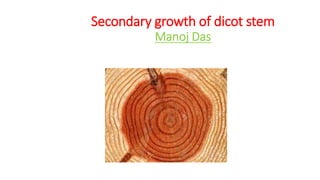
Secondary growth of dicot stem
- 1. Secondary growth of dicot stem Manoj Das
- 2. Secondary growth in dicot stem • The secondary growth can be defined as an increase in the diameter or girth of the axis by the addition of secondary tissue in extra stelar and stelar regions due to the activities of vascular cambium and cork cambium. It is the diagnostic character of gymnosperms and dicots. It is absent in monocots due to the lack of cambium except Yucca, Dracaena palms etc. • The secondary growth in dicot stem involves as- • I. By the activity of vascular cambium • 1. In dicot stem, the vascular bundles are conjoint, collateral open type and arranged in a ring. The vascular cambium is present in the form of a thin strip between the primary xylem and phloem known as fascicular cambium. In the medullary rays, it is present as
- 3. interfascicular cambium between the neighbouring vascular bundles. 2. The joining of fascicular and interfascicular cambia leads to the formation of a complete ring called as cambium ring. 3. The fascicular cambium produces secondary phloem to the outer side and secondary xylem to the inside by mitotic divisions. The amount of secondary xylem produced is much more than the secondary phloem because the cambium is more active on the inner side than the outer side. The cambium cells divide radially to increase the growth in circumference and tangentially to form secondar xylem and secondary phloem. Primary phloem gets pushed outwards and primary xylem inwards towards the pith.
- 5. 4. The secondary xylem occupies the major portion of the stem forming a hard compact mass. The secondary medullary rays are the living cells that run radially from pith to cortex. They form a connection to transport sap and food radially across the stem. These may also used for storage of food during winter. Primary xylem get pushed toward the center and become non functional, the pith gets reduced. Primary phloem gets crushed and is pushed outwards. With the increase of secondary xylem, some of the peripheral tissue also get stretched. It brings about the rupture of
- 6. endodermis, cortex and epidermis. These are replaced by cork that develops from the cork cambium. Some related terms Dendrochronology- It is the branch of plant anatomy that determine the age of plants by counting of annual rings. Annual ring= spring wood + autumn wood Spring or early wood-It is the wood formed during spring or early summer. The vessels have large cavities and thin walls to increase the rate of transport. Autumn or late wood- It is the wood formed during autumn or winter. Vessels are fewer in number. They have narrow cavities and thick walls.
- 7. Annual ring- It is formed by combination of spring wood and summer wood of a year.
- 8. • Porous and non porous wood • In the gymnosperms, vessels are absent and the wood is entirely made of tracheids. Such wood is called as non porous wood. • In dicots, the wood made up of tracheids and vessels is called as porous wood. • Heart wood and sap wood • In the older trees, two types of wood heart wood and sap wood are present. Differences between heart wood and sap wood are as
- 9. Heart wood or duramen • It occupies the central region of wood. • It is dead part of wood. • It provides mechanical support to the plant body. • It is dark in colour due to the deposition of tannin, gum, resin. • It is resistant against termites, microbe fungi etc. Sap wood or alburnum • It lies at the peripheral region of wood. • It is living part of the wood • It helps in conduction of sap and food materials. • It is lighter in the color. • It is suspectable to the termites, microbes fungi etc.
- 11. Soft wood and hard wood • Soft wood- It occurs in the gymnosperms mainly in conifers and made up of entirely tracheids and non porous. • Hard wood- It occurs in dicots and made up of both tracheids and vessels. It is porous wood.
- 14. II. By the activity of cork cambium • With the growth of secondary xylem, the tissue on outer side become compressed and stretch side ways. Ultimately, the epidermis ruptures. The cells of meristematic tissue i.e cork cambium or phellogen which lie just below the epidermis produce cork or phellem to outside and secondary cortex or phelloderm to the inside. The epidermis is relaced by periderm which is made of cork cambium or phellogen, cork or phellem and secondar cortex or phelloderm.
- 16. Some related terms • a. Cork- the cork cells are dead, prism like in structure and highly suberinised. It is brown in colour. Being light, waterproof and highly compressible, it is used as stopper for bottles. • b. Bark – All the tissues outside the vascular cambium form bark. It includes periderm, phloem and cortex. It may be- • Ring bark- If the cork cambium forms a complete cylinder of bark around the stem, the bark is called as ring bark and occurs in Betula utilis commonly known as bhojpatra. • Scale bark- If the cork cambium produces small strips of bark is called as scale bark and occurs in Psidium guajava Eucalyptus etc.
- 17. • Lenticels- These are small opening pores in the periderm that allow gaseous exchange. They appear as scars or raised portions on the surface of stem. These usually appear below the stomata.